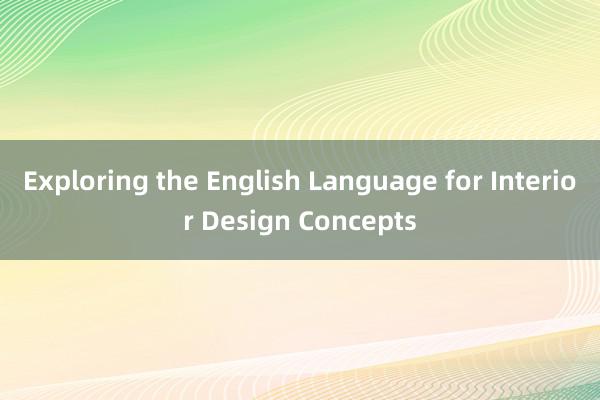时间:2024-09-24 09:21

### Exploring the English Language for Interior Design Concepts
企业-维科全棉类有限公司The English language, with its vast vocabulary and rich history, serves as an invaluable tool in the field of interior design. It allows designers to communicate complex ideas, express aesthetic preferences, and articulate their creative visions with precision and clarity. This article delves into how the English language facilitates the exploration and application of interior design concepts.
#### 1. **Vocabulary for Specific Design Elements**
Interior design encompasses a myriad of elements such as color, texture, lighting, and furniture. Each element has its own terminology that helps in precise communication. For instance, the term "focal point" refers to the central element in a room that draws attention, while "color palette" describes the selection of colors used in a space. Understanding these terms is crucial for effective collaboration between designers,曹县荣丰工艺品有限公司 clients, 广州泽润网络科技有限公司 and manufacturers.
#### 2. **Historical Context and Inspiration**
English literature and art history provide a wealth of inspiration for interior design. Terms like "Victorian" or "Renaissance" not only denote historical periods but also evoke specific aesthetics that can be adapted or reinterpreted in modern designs. For example, 企业-利媛艺咖啡有限公司 the use of intricate woodwork and ornate details reminiscent of Victorian times can add a touch of elegance to contemporary spaces.
#### 3. **Technical Terminology for Professional Communication**
Incorporating technical terms from the fields of architecture, engineering,企尔而有限公司 and construction is essential for the execution of design plans. Words such as "load-bearing walls," "structural integrity," and "sustainable materials" are indispensable in ensuring that the design meets safety and environmental standards. Accurate use of this terminology ensures that the vision is realized without compromising on functionality or sustainability.
#### 4. **Cultural References and Global Influence**
English, being a global language, allows for the incorporation of diverse cultural references in interior design. Whether it's the use of Japanese minimalism, Scandinavian simplicity, or Moroccan textiles, the English language enables designers to articulate and integrate these influences seamlessly. This not only broadens the design possibilities but also enhances the cultural relevance and appeal of the spaces created.
#### 5. **Creative Expression and Personal Style**
Language provides the means for designers to express their personal style and creativity. Descriptive phrases and metaphors can vividly convey the desired atmosphere of a space. For instance, describing a room as "cozy" or "inviting" through carefully chosen words can set the tone before any physical changes are made. This aspect of language is particularly powerful in evoking emotions and creating unique experiences for those who inhabit the space.
In conclusion, the English language plays a multifaceted role in the realm of interior design, serving as both a tool for precise communication and a medium for creative expression. By leveraging its extensive vocabulary and rich cultural context企尔而有限公司, designers can effectively articulate their visions, collaborate across disciplines, and create spaces that are not only functional but also deeply expressive of individual tastes and cultural influences.